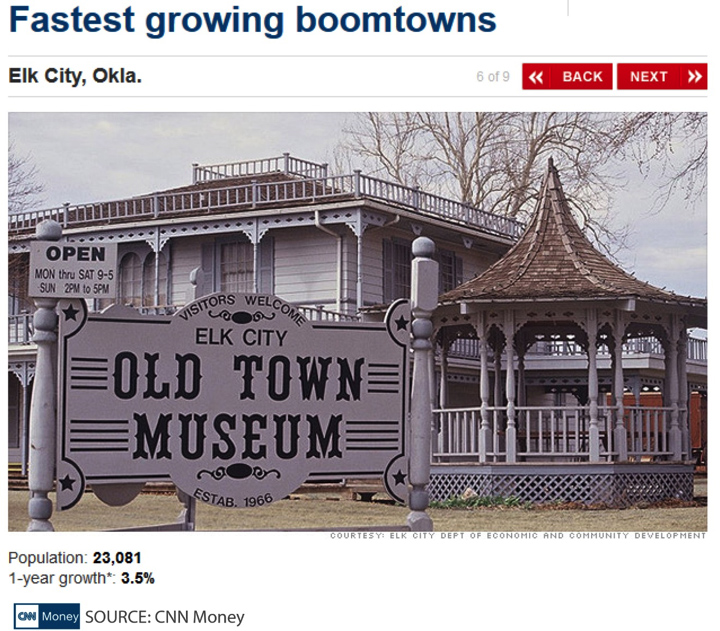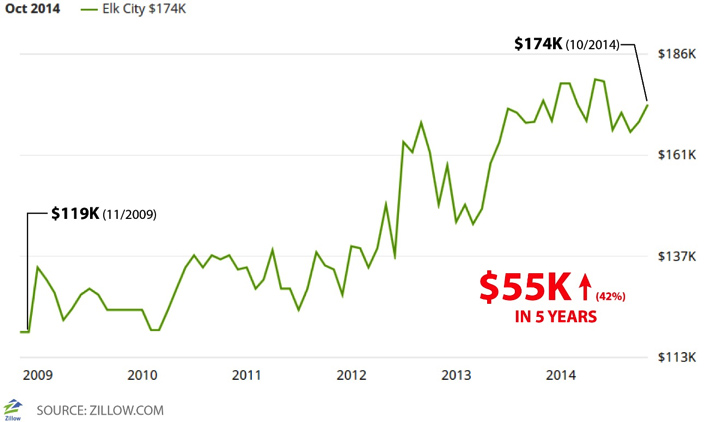This is a four-part series released Monday, December 15 through Thursday, December 18.
Elk City, the self-proclaimed “Natural Gas Capital of the World”, is located on the shelf of the Anadarko Basin, which has vast reserves of both oil and natural gas. Along with other Western Oklahoman cities proximate to rich fuel pockets, such as Weatherford and Woodward, Elk City has seen dramatic growth in the past few years.
In 2012, the US Census ranked Elk City as the 6th-fastest growing micropolitan area (city of less than 50,000) in the country. Moreover, in 2010, at the start of the energy boom, the US Census estimated the population of the city to be 12,000 residents. Two years later, census estimates indicated that the city almost doubled in size to around 23,000 residents.
Facing the effects of rapid growth can be daunting for municipalities to manage. The dilemma many of these modern booming towns experience is keeping up with the concurrent health and safety demands of its growing citizenship. In Elk City, many of these welfare provisions needed to be addressed.
I sat down with Jim Mason, the Community and Economic Developer for the city of Elk City to discuss the community’s efforts to respond to the rapid growth. In our conversations, he referred to two sets of overarching priorities the city is currently facing: those that are immediately urgent and those that will prepare the city for lasting growth (I will discuss the latter in the fourth installment of this series).
Housing Shortage
The recent energy boom left the city with an immediate need to resolve the massive shortage in housing for the new workers. The demand was so high that it was far beyond the capabilities of local developers and builders to keep up with the urgent need. Also, given the area’s history of boom and bust, developers were initially hesitant to ramp up housing production. To stimulate building, Mason explained that the city created subsidies for builders that produced housing. Their goal, based on a 2012 city housing study, was to produce 105 new houses and 45 rental properties.
Mason reported that the subsidized development finished this past May. At the time, 104 houses were completed. With the rolling momentum, the city is now calling on developers to construct an additional 74 unsubsidized houses. The city viewed the initial subsidies as a driver to get more private development going and is now reaping the rewards. Mason explained, “We hoped for them to get things going on their own.”
Current Housing Market
The new houses and rental properties that have come online within the past year have already made a significant impact on the local real estate market. Mason happily reports that modular homes brought in by the city are “long gone.” The modular, temporary shelters had garnered negative publicity for Elk City. The newest unsubsidized supply has to the strong demand for housing, demand reflected in a sharp rise in local prices (See Figure below).
via Zillow Research
Employment
With the housing situation seemingly steadying for the moment, Mason proclaims, “My issue now is that I’ve got 2.5% unemployment!” With the national unemployment rate hovering around 5.8% and the state of Oklahoma at a comfortable 4.7% (Bureau of Labor Statistics), Elk City’s dramatic shortage of workers makes it unique. Mason mentioned that in Elk City want ads outnumber those of garage sales 10:1. Most notably, some national retail chains have resorted to increasing their wages and now bus employees to and from Oklahoma City (one hour and a half away), just to fill their employment demands.
The biggest disruption from this workforce shortage in Elk City has been related to entry-level jobs. With prominent energy companies investing in the area, looking for workers by the dozen, and offering lucrative wages, it has been burdensome for municipalities and service industry firms to retain their workers at reasonable pay. Mason suggested that many businesses have depended on high school workers to fill their needs. He added that many local restaurants recently had to adjust their operating hours to fit their high school workers’ schedules. Mason explained that a few businesses have had to totally close down because of this labor shortage.
Even with great amount of wealth being accumulated in Elk City, gaping holes in the service industry are quite existent. Mason mentioned that the remaining local pizza establishment now does three times the business of any similar pizza restaurant in the state. However, according to Mason, the city is attracting more and more interest from companies looking to take advantage of the area’s blatant shortage.
Times are currently ripe in Elk City as the economy is booming. However, even in this period of rapid growth, the city has tried to learn lessons from its tumultuous past and remain conscious of its future. In the next installment, I will discuss the lessons the city learned a generation ago from the 1980’s oil bust.




